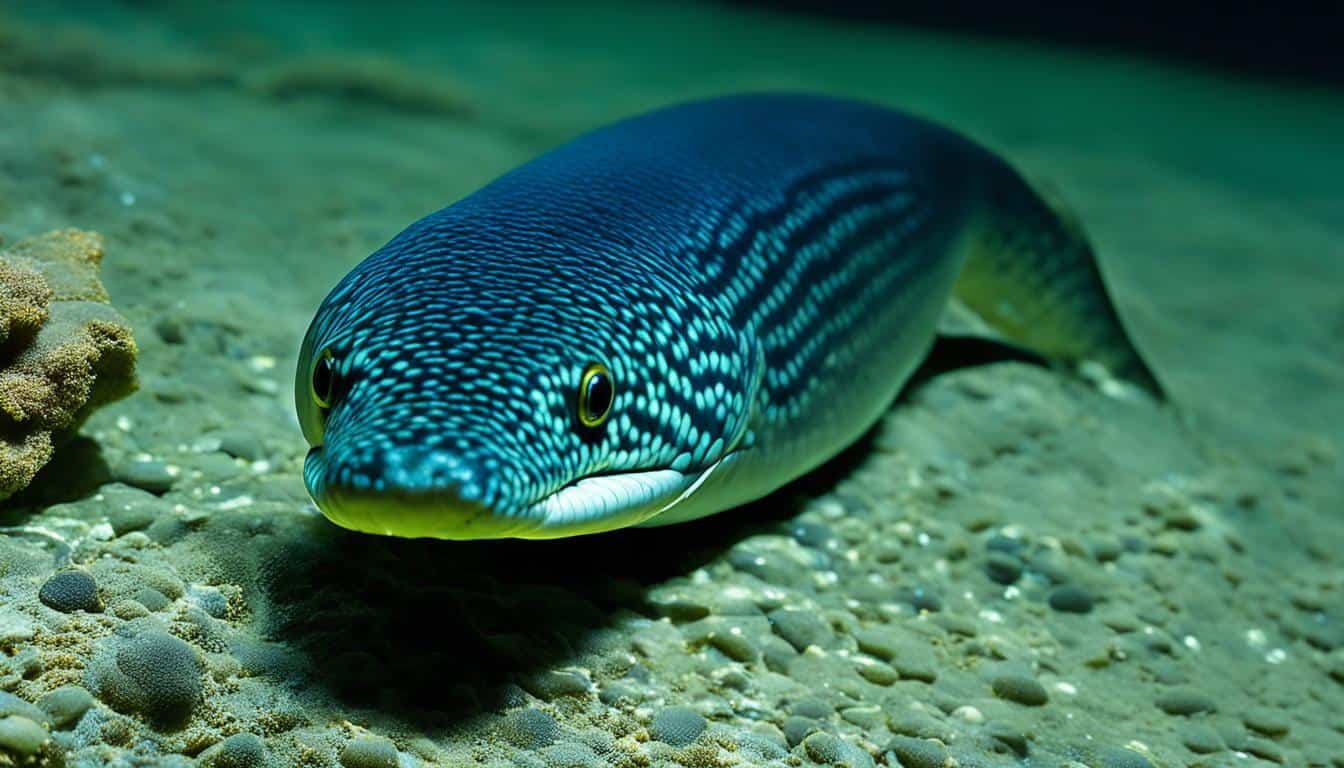Electric eels, known as Electrophorus electricus, can create a lot of electricity. You might ask, how do they do it? Let’s dive into their biology and ecology to find out. These eels live in South America’s freshwater and use special parts and behaviors to make electricity. We’ll look at their anatomy, the science of their electricity, and how they use it for hunting, defense, and talking to each other.
Understanding Electric Eels: A Brief Overview
Electric eels are fascinating creatures with unique traits. They are not true eels but part of the knifefish family. Let’s dive into their biology, environment, and what makes them special.
What Are Electric Eels?
Known as Electrophorus electricus, electric eels can reach up to 2.5 meters long and weigh about 20 kg. Their looks and electric shock ability grab the interest of many. Found in South America, they live in freshwater.
Electric Eel Anatomy
Their body is built for making electricity. They have three main electric organs. These organs have cells called electrocytes that help them produce electric discharges. This lets them survive in low-oxygen environments by hunting and moving around effectively.
Habitat of Electric Eels
Electric eels live in slow-moving waters like rivers, creeks, and floodplains. They are found in the Amazon and Orinoco basins, where they have plenty of food and places to breed. Their electric senses help them move and hunt in muddy waters.
The Science Behind Electric Discharges
Electric eels are truly amazing creatures. Their abilities show how nature can adapt in incredible ways. At the heart of this is the electric organ. It’s a complex structure that helps them produce and release electricity.
What is an Electric Organ?
The electric organ is made of special tissues for making electrical energy. It’s found along the electric eel’s body. These organs are key for defense and hunting.
They have electrocytes, which are flat cells that make electricity through electrochemical processes. These cells work together to build up electrical charges. These charges can reach high voltages, helping the eel in different situations.
The Role of Electrocytes in Electricity Production
Electrocytes are the main power source of the electric organ. Each one acts like a battery cell, making about 150 millivolts. When stacked together, the voltage gets much higher.
Arranging them in parallel increases the current. This is like many batteries working together to make lots of electricity. With up to 10,000 electrocytes per column, electric eels can produce over 500 volts and 1 ampere of current. This makes them some of the most efficient electric generators in nature.
How do electric eels produce electricity?
Electric eels have a unique way of making electricity. It’s a mix of biology and physics. They have special organs and a well-coordinated nervous system. This lets them make electric currents.
Mechanism of Electric Current Generation
They make electricity with cells called electrocytes. These cells layer together to create a big potential difference. When the nervous system sends a signal, sodium ions move into the cells.
This changes the charge across the cell membrane. It starts an electric current that can reach up to 600 volts. This depends on the species and the eel itself.
Nervous System Coordination
The nervous system of electric eels is key to making electricity. The brain sends signals that make the electrocytes discharge at the same time. This creates strong electric shocks that can stun prey.
This coordination means the electric discharges are quick and last only about two milliseconds. This way, the electric current spreads out in the water without hurting the eel.

Electric Eel Behavior and Hunting Techniques
Electric eels have fascinating ways of hunting that show how well they adapt to their world. They use their electric powers to stun their prey, making it easier to catch. They also use electricity to talk to each other, showing how important it is in their lives.
Stunning Prey with Electric Shocks
Electric eels can send out strong electric discharges to stun fish and other animals. This helps them catch their food and eat it easily. It’s very useful in murky waters where you can’t see very well. This shows how smart their hunting ways are.
Using Electricity for Communication
Electric eels use electricity to talk to each other too. They send out weak electric signals to help them move around and avoid hitting things in the dark. This shows how important electricity is for them, both for hunting and talking to each other.
Electrolocation: The Eel’s Unique Sense
Electric eels have a special way of sensing their world called electrolocation. It’s key for finding food and moving around in dark places. This skill helps them live in places where it’s hard to see.
Active and Passive Electrolocation
Active electrolocation is when electric eels send out weak electrical signals to feel their way around. They use these signals to sense objects and other living things. On the other hand, passive electrolocation lets them detect electric fields from others, helping them find food or danger without touching it.
How Electric Eels “See” in Murky Waters
In murky waters, seeing is tough, but electric eels use electrolocation to “see” anyway. This skill helps them avoid obstacles, find food, and talk to other eels. Their use of both active and passive electrolocation shows how they’ve adapted to survive in tough environments.
FAQ
How does an electric eel generate electricity?
Electric eels make electricity with special organs called electric organs. These organs have electrocytes that work together to create high voltage. This electricity helps them hunt, defend themselves, and communicate.
What is unique about electric eel anatomy?
Electric eels have a special body with three types of electric organs. These organs have thousands of electrocytes. This setup lets them live in low-oxygen waters and helps them make electricity.
Where do electric eels typically live?
Electric eels live in slow-moving freshwater in South America. They are found in creeks and swamps, especially in the Amazon and Orinoco river basins.
What are the functions of electric organs in electric eels?
Electric organs help electric eels in several ways. They stun prey for easier capture, communicate with other eels, and help them navigate through murky waters.
How do electrocytes contribute to electricity production?
Electrocytes are special cells in electric organs that make electricity. When activated, they create a potential difference. This discharges energy, producing up to 500 volts.
How do electric eels use their electrical discharges for hunting?
Electric eels use electric shocks to stun their prey. This makes it easier for them to catch fish, invertebrates, and sometimes small mammals.
What communication methods do electric eels employ?
Electric eels use weaker electric discharges to communicate and navigate. These low voltages help them talk to other eels and understand their environment in dark waters.
What is electrolocation, and how do electric eels use it?
Electrolocation is a way electric eels sense their environment with electric fields. They send out weak electrical pulses to detect changes in these fields. This helps them find prey and avoid obstacles.
What are the differences between active and passive electrolocation?
Active electrolocation means electric eels send out their own electric pulses to feel their surroundings. Passive electrolocation is when they detect electric fields from other creatures. Both methods are key for hunting and moving around in dark waters.







